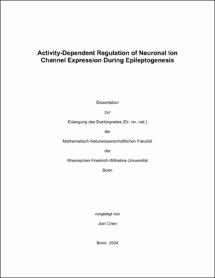Chen, Jian: Activity-Dependent Regulation of Neuronal Ion Channel Expression During Epileptogenesis. - Bonn, 2005. - Dissertation, Rheinische Friedrich-Wilhelms-Universität Bonn.
Online-Ausgabe in bonndoc: https://nbn-resolving.org/urn:nbn:de:hbz:5N-04908
Online-Ausgabe in bonndoc: https://nbn-resolving.org/urn:nbn:de:hbz:5N-04908
@phdthesis{handle:20.500.11811/2131,
urn: https://nbn-resolving.org/urn:nbn:de:hbz:5N-04908,
author = {{Jian Chen}},
title = {Activity-Dependent Regulation of Neuronal Ion Channel Expression During Epileptogenesis},
school = {Rheinische Friedrich-Wilhelms-Universität Bonn},
year = 2005,
note = {Status epilepticus (SE) is known to cause numerous structural and functional alterations in brain. In this study, expression of various voltage-gated ion channels in rat hippocampal CA1 neurons were investigated at different time points after an episode of SE induced by pilocarpine. First, with microarray, gene expression profiling data revealed expression alterations in several voltage-gated ion channel subfamilies. Then, with absolute real-time RT-PCR quantification, we found GAPDH were significantly increased in the SE experienced neurons, whereas the neuron-specific gene synaptophysin appeared stable. This was also proved by in situ hybridization. Using synaptophysin as reference gene, real-time RT-PCR relative quantification was applied to determine the expression changes of several groups of voltage-gated ion channels related to intrinsic excitability in CA1 neurons. They were voltage-gated Ca2+ and Na+ channels; KCNQ channels, A-type K+ channels; and HCN channels. The most important and interesting parts are below: (1) Cav3.2 mRNA that underlies the T-type Ca2+ currents was transiently increased at day 3 in SE experienced samples. (2) And the persistent down-regulation of KCNQ2 mRNA was also found after SE. This channel is responsible to the M-currents, one type of voltage-gated K+ currents, which play a critical roll in determining the sub-threshold electrical excitability of neurons. We thus suggest that intrinsic plasticity is a potent mechanism that, in conjunction with synaptic plasticity, can fundamentally alter the input-output properties of neuronal networks in the mammalian brain.},
url = {https://hdl.handle.net/20.500.11811/2131}
}
urn: https://nbn-resolving.org/urn:nbn:de:hbz:5N-04908,
author = {{Jian Chen}},
title = {Activity-Dependent Regulation of Neuronal Ion Channel Expression During Epileptogenesis},
school = {Rheinische Friedrich-Wilhelms-Universität Bonn},
year = 2005,
note = {Status epilepticus (SE) is known to cause numerous structural and functional alterations in brain. In this study, expression of various voltage-gated ion channels in rat hippocampal CA1 neurons were investigated at different time points after an episode of SE induced by pilocarpine. First, with microarray, gene expression profiling data revealed expression alterations in several voltage-gated ion channel subfamilies. Then, with absolute real-time RT-PCR quantification, we found GAPDH were significantly increased in the SE experienced neurons, whereas the neuron-specific gene synaptophysin appeared stable. This was also proved by in situ hybridization. Using synaptophysin as reference gene, real-time RT-PCR relative quantification was applied to determine the expression changes of several groups of voltage-gated ion channels related to intrinsic excitability in CA1 neurons. They were voltage-gated Ca2+ and Na+ channels; KCNQ channels, A-type K+ channels; and HCN channels. The most important and interesting parts are below: (1) Cav3.2 mRNA that underlies the T-type Ca2+ currents was transiently increased at day 3 in SE experienced samples. (2) And the persistent down-regulation of KCNQ2 mRNA was also found after SE. This channel is responsible to the M-currents, one type of voltage-gated K+ currents, which play a critical roll in determining the sub-threshold electrical excitability of neurons. We thus suggest that intrinsic plasticity is a potent mechanism that, in conjunction with synaptic plasticity, can fundamentally alter the input-output properties of neuronal networks in the mammalian brain.},
url = {https://hdl.handle.net/20.500.11811/2131}
}






